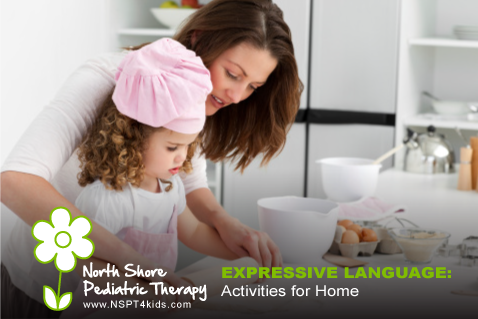“I wish I could help my child talk more”. Well… You can! Expressive language can be elicited in a number of different ways. Most of the toys or activities you already have in your home can help your child begin to talk more and practice expressive language skills.
10 Expressive Language Activities:
- Books: Books are a great way to elicit expressive language in children. The important thing to remember when reading books with your child is to ask OPEN ENDED questions. This takes some practice but the best way to help children talk more is to ask them a question where they generate their own answers. For example, “what is she doing?” “How is he feeling?” “What’s happening in this picture?”. These are open ended questions versus yes or no questions or questions with one word answers.
- Wordless books: Wordless books are great for younger children who are working on developing expressive language skills. With younger children, you can ask them direct questions like, “What is this?” or “What color is this?”. You can expand upon your child’s answers by saying things like, “You’re right; that’s a cat. He’s a black cat”. This will help model language and provide good input as well as working on output.
- Pretend play: Pretend play can target higher level expressive language skills. When pretending or building a scenario, your child is working on storytelling and sequencing activities. Always ask your child open ended questions when engaging in pretend play. This allows them to create the scenario and path as opposed to limiting their language with a single word answer. Some examples of questions are, “What should happen next?” or “Where should we go? Who should come with us?”.
- Cooking is a great way to target expressive language through sequencing. Have your child narrate the steps of your recipe. This can be done by having her look over all the ingredients (either by reading words or by naming what she sees in front of her). Then, you can ask them to monitor and narrate what you have done, what you are doing, and what you still need to do.
- Playdough: Playdough can be used to build scenery, animals, food or any number of creations. Allow your child to express what she wants to create or what she wants you to build. Cookie cutters or other molds can help aid children if they are having trouble utilizing their imagination to build with playdough. This is a great opportunity to have your child request more or different playdough by using an, “I want….” Or an “I need…” phrase.
- Toy animals: Toy animals can be used similarly to pretend play. Again, be sure to ask open ended questions. This is also another opportunity to have your child utilize “I want…” or “I need…” phrases. Ask your child to narrate or express what the animals are/should be doing.
- Train sets/cars: Cars and trains can be used in a similar manner that toy animals would be used. Cars or trains sometimes come with tracks or ramps. If you don’t have ramps, you can improvise by using a table or another piece of furniture. You can utilize these tracks or ramps to have your child verbalize “go again” or “go up/down” or “ready…set…go”.
- Dress up: Dress up can be incorporated into pretend play or an entire activity in itself. You can have your child express what they want to wear or what they want you to wear. Ask them open ended or imaginative questions such as, “where should we go now that we’re all dressed up?” or “who are we?”.
- Play food: Your child can pretend they are cooking and/or serving you food. Have them ask you what you’d like to eat, or express to you what they are cooking, how they are cooking it, and who they are serving. You can also use a puppet with pretend food with the younger children. Have the children feed the puppet and tell it, “Eat banana” or “eat the apple puppet”. You can engage them by pretending to either enjoy or dislike the food in an exaggerated manner. Have them say whether they thought the puppet enjoyed the food or did not like it.
- Bubbles: Bubbles are a great tool to use with younger children. Blow bubbles and then pause. Ask your children to say, “More bubbles!” or “My turn.” if they are old enough to blow the bubbles themselves.
When targeting expressive language through activities or toys, always remember the following points:
- Use open ended questions
- Always have your child request an item before just handing it to them
- Have your child request another turn
- Have your child narrate what they are doing or what they want you to do
With these tips you can turn any toy or activity into an expressive language task!












